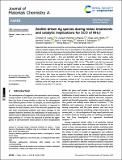Por favor, use este identificador para citar o enlazar a este item:
http://hdl.handle.net/10261/268388COMPARTIR / EXPORTAR:
 SHARE SHARE
 CORE
BASE CORE
BASE
|
|
| Visualizar otros formatos: MARC | Dublin Core | RDF | ORE | MODS | METS | DIDL | DATACITE | |

| Título: | Zeolite-driven Ag species during redox treatments and catalytic implications for SCO of NH3 |
Autor: | Lopes, Christian W.; Martinez-Ortigosa, Joaquin; Gora-Marek, K.; Tarach, Karolina; Vidal-Moya, Alejandro CSIC ORCID; Palomares Gimeno, Antonio Eduardo; Agostini, Giovanni; Blasco, Teresa CSIC ORCID; Rey García, Fernando CSIC ORCID CVN | Fecha de publicación: | 25-nov-2021 | Editor: | Royal Society of Chemistry (UK) | Citación: | Journal of Materials Chemistry A 9(48): 27448-27458 (2021) | Resumen: | Supported silver species are among the most promising catalysts for the depletion of ammonia emission by selective catalytic oxidation (NH-SCO). Here, an investigation on the influence of small pore CHA and RHO zeolite structures on the silver species formed and their catalytic activity for the NH-SCO reaction has been conducted. To this end, AgRHO(4) and AgCHA(4) zeolites with similar Si/Al molar ratios (≈ 4) and silver content (∼15 wt%, Ag/Al ≈ 0.6), and AgCHA(2) with Si/Al ≈ 2 and higher silver loading, while maintaining the Ag/Al ratio (∼26 wt%, Ag/Al ≈ 0.6), have been submitted to different treatments and characterized by using a large variety of techniques (XRD, UV-Vis,Ag NMR,in situXAS andoperandoFT-IR). The reduction of the AgCHA and AgRHO zeolites at low temperature (100-200 °C) produces silver clusters, which remain in the AgRHO zeolite when the temperature is increased to 400 °C. However, the silver species in the AgCHA zeolites evolve to nanoparticles (NPs) at 400 °C under H. The catalytic tests show that metal particles are the active sites while silver clusters are inactive for the NH-SCO reaction. Also, there are important differences in the stability of the reduced Ag species under oxidizing or under reaction conditions at 400 °C. Metal NPs are partially redispersed and oxidized to (Ag), while silver clusters are completely oxidized to Ag. Our results indicate that silver clusters are stabilized in the RHO-type and not in the CHA-type zeolite, and thus they display very different catalytic activities for the NH-SCO reaction. | Versión del editor: | http://dx.doi.org/10.1039/d1ta09625g | URI: | http://hdl.handle.net/10261/268388 | DOI: | 10.1039/d1ta09625g | Identificadores: | doi: 10.1039/d1ta09625g issn: 2050-7496 |
| Aparece en las colecciones: | (ITQ) Artículos |
Ficheros en este ítem:
| Fichero | Descripción | Tamaño | Formato | |
|---|---|---|---|---|
| Zeolite-driven Ag.pdf | 1,63 MB | Adobe PDF |  Visualizar/Abrir |
CORE Recommender
SCOPUSTM
Citations
10
checked on 02-may-2024
WEB OF SCIENCETM
Citations
8
checked on 27-feb-2024
Page view(s)
34
checked on 02-may-2024
Download(s)
39
checked on 02-may-2024
Google ScholarTM
Check
Altmetric
Altmetric
Este item está licenciado bajo una Licencia Creative Commons

